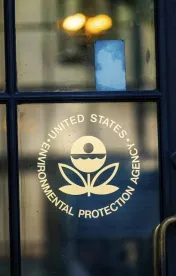On March 29, 2023, the US Environmental Protection Agency (EPA) published in the Federal Register its long-awaited proposed rule to restrict certain per- and polyfluoroalkyl substances (PFAS) in drinking water under the Safe Drinking Water Act (SDWA). This action is part of EPA’s whole-of-agency approach in its PFAS Strategic Roadmap and is expected to directly affect 66,000 public water systems across the country. Comments on the proposal are due on May 30, 2023. EPA will also hold a public hearing on May 4, 2023 to receive stakeholder input on this important rulemaking.
EPA is proposing the National Primary Drinking Water Regulation (NPDWR) establishing legally enforceable Maximum Contaminant Levels (MCLs) and health-based, non-enforceable Maximum Contaminant Level Goals (MCLGs) for six PFAS.

MCLs and MCLGs
An MCL is the maximum level of a contaminant permitted in potable water that is delivered to a consumer from a public water system. The proposed MCLs for PFOA and PFOS are near the practical level of detection, as described by EPA, the minimum level of quantitation for currently approved analytical methods. EPA determined in December 2021 that at least 75 percent of laboratories in the US should be capable of reliably measuring PFOA and PFOS down to 4.0 ppt using Method 533 and Method 537.1.
In setting the MCL, EPA considered the factors required by SDWA, including costs, benefits, feasibility, and currently available analytical methods to measure and treat these chemicals in drinking water, in proposing the MCLs for PFOA and PFOS. MCLGs, on the other hand, do not consider analytical measurement limits or treatment technology effectiveness. EPA proposes MCLGs of zero for PFOA and PFOS because it determined that these PFAS are likely to cause cancer, and that there is no dose below which either chemical is considered safe, consistent with longstanding Agency policy that there is no threshold level that is considered “acceptable” for known or probable carcinogens.
The four other PFAS in the proposal, PFNA, PFHxS, PFBS, and GenX, were not previously understood to be under consideration because EPA had not previously published a regulatory determination for these substances. EPA is now doing so simultaneously with the proposed rule and has released a preliminary regulatory determination that HFPO-DA (and its ammonium salt, collectively known as GenX chemicals), PFHxS, PFNA, PFBS, and mixtures thereof should be contaminants subject to regulation under the SDWA. EPA already issued a final regulatory determination to regulate PFOA and PFOS as contaminants in March 2021. EPA requests comment on its preliminary determination.
For the four PFAS, EPA proposes to use a novel hazard index approach to determine if combined level of these PFAS pose a risk to human health. This is because EPA found that the four PFAS likely co-occur in drinking water, and that exposure to such a PFAS mixture can be assumed to act in a dose-additive manner. Therefore, EPA believes that low levels of multiple PFAS, while individually may not result in adverse health effects, would result in adverse health effects when combined. EPA notes that its Science Advisory Board has opined that, where health endpoints of compounds are similar, it is reasonable to use a hazard index for estimating potential aggregate health hazards associated with the occurrence of chemical mixtures in environmental media, since the hazard index indicates overall potential risk of a mixture as well as individual PFAS that are potential drivers of risk.
Monitoring
EPA intends this rulemaking to significantly reduce PFAS in drinking water in the US. As with other contaminants subject to MCLs, EPA will require public water systems to monitor these PFAS and notify the public if levels exceed the MCLs. Public water systems that exceed these MCLs must take action to reduce exposure to the listed PFAS.
Compliance and Treatment Technologies
EPA estimates that over 66,000 public water systems will be subject to this rule if finalized and expects 3,400-6,300 systems to exceed one or more of the proposed PFAS MCLs. It estimates that compliance costs associated with the proposed rule will be between $772 million and $1.2 billion (present value in 2021 dollars when factoring in discount rates of 3-7 percent). EPA expects water systems’ annual costs to increase by an additional $30-$61 million in disposal costs if spent media is categorized as hazardous waste. Nevertheless, EPA concluded that the public health benefits, including quantified and non-quantified benefits, justify the costs its rule would impose on public water systems and consumers.
EPA acknowledges that compliance will require public water systems to invest in new water infrastructure technology. It identifies three treatment technologies – granular activated carbon, anion exchange (AIX), and high-pressure membrane technologies. Alternatively, public water systems can consider switching to new uncontaminated source water.
Available Federal Funding
EPA notes that the Infrastructure Investment and Jobs Act, also referred to as the Bipartisan Infrastructure Law, invests over $11.7 billion in the drinking water state revolving fund (SRF), including $4 billion to the drinking water SRF for emerging contaminants and $5 billion to small, underserved, and disadvantaged communities grants. EPA states that these funds will assist water systems address PFAS with the installation of treatment when it might otherwise be cost-challenging, as well as testing, technical assistance, and contractor training.








 />i
/>i

